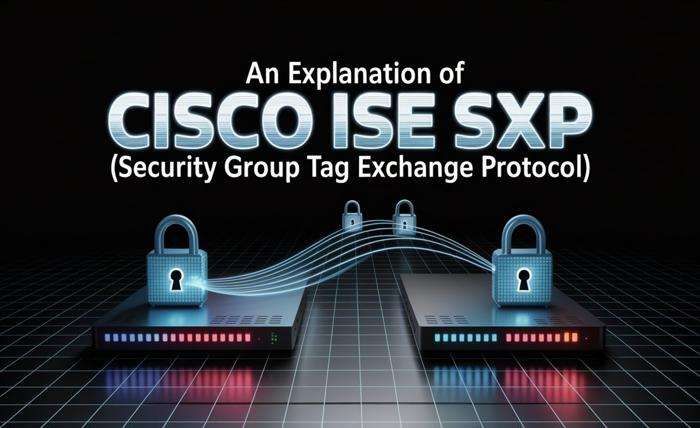
Cisco ISE SXP is a vital component in enabling identity-based access control within enterprise networks. As organizations grow more complex with mobile users, IoT devices, and cloud applications, traditional IP-based access control methods fall short. Cisco’s Identity Services Engine (ISE) addresses this challenge by offering dynamic, role-based policy enforcement across wired, wireless, and VPN infrastructures.
A key topic covered in Cisco ISE training, SXP—short for Security Group Tag Exchange Protocol—plays a crucial role in Cisco TrustSec deployments. It allows for the secure sharing of Security Group Tags (SGTs) between devices, ensuring consistent and scalable policy enforcement even in networks with mixed device capabilities.
What Is SXP in Cisco ISE?
SXP, or Security Group Tag Exchange Protocol, is a Cisco proprietary control protocol used to propagate IP-to-SGT (Security Group Tag) mappings from devices that learn and assign tags to those that enforce policies using them. This functionality enables identity-based segmentation even on network devices that do not support inline tagging of packets.
SXP operates over TCP and forms peer connections between Cisco ISE or TrustSec-enabled devices (called Speakers) and enforcement devices (called Listeners). These devices use the shared information to apply Security Group Access Control Lists (SGACLs), allowing or denying access between different segments of the network based on assigned roles.
Why SXP Matters in Enterprise Security
The ability to propagate SGTs across the network means policies no longer depend on IP addresses or physical location. Instead, user identity, device type, and security posture drive access decisions. SXP plays a crucial role in enabling this identity-based control across all parts of the infrastructure—even in legacy environments.
Key benefits of SXP include:
- Enforcing role-based access control across multi-vendor or mixed-capability environments.
- Enablingsegmentation in networks without native TrustSec
- extendingthe visibility and control of Cisco ISE to devices that are unable to perform inline SGT tagging.
How SXP Works
SXP enables out-of-band exchange of IP-to-SGT bindings. When a device like Cisco ISE authenticates a user, it assigns an SGT to that user’s IP address. SXP then sends this binding to one or more Listener devices. These listeners use the received mappings to apply access control policies, ensuring that users can only access resources relevant to their roles.
SXP operates in a unidirectional mode. A device configured as a Speaker sends binding information, while the Listener receives it. Some deployments may require a device to act as both, depending on the network’s topology.
Key Components of an SXP Binding
To better understand how SXP functions, consider the following components of an IP-to-SGT binding:
| Component | Description |
| IP Address | The IP address of the authenticated endpoint |
| SGT (Security Group Tag) | Numeric label that classifies the endpoint’s role (e.g., Employee, Guest) |
| Speaker | The device or ISE node that creates and sends the binding |
| Listener | The device that receives the binding and uses it to enforce policies |
| Connection Role | Defines whether a device is sending or receiving bindings |
| Connection Status | Indicates whether the SXP session is up, idle, or deleted |
Real-World Use Cases for SXP
SXP is especially powerful in large, distributed, or hybrid networks. Here are several common scenarios where it provides value:
1. Extending TrustSec to Legacy Devices
Older switches and routers may not support inline SGT tagging. SXP lets them enforce identity-based policies by receiving IP-to-SGT bindings from Cisco ISE or capable devices.
2. Remote Office Policy Enforcement
In a branch-office scenario, SXP delivers bindings to edge routers or firewalls, enabling consistent access control policies for remote users connecting via WAN or VPN.
3. VPN and Wireless Access
When users connect remotely or wirelessly, Cisco ISE assigns SGTs based on authentication. These bindings are distributed through SXP to firewalls, WLCs, or routers that enforce access control policies.
SXP Design Considerations
When designing and deploying SXP in your Cisco ISE-based network, consider the following:
- Authentication and Integrity: Ensure peers authenticate each other to prevent rogue devices from injecting incorrect bindings.
- Scalability:In large deployments, manage SXP peer relationships carefully to avoid excessive overhead or binding duplication.
- Resiliency: Redundant peer connectionsimprove high availability and reduce the risk of policy gaps.
- Visibility:Regularly monitor SXP sessions, binding status, and log entries to validate that policies are applied as expected.
Limitations of SXP
Despite its advantages, SXP has some limitations:
- Itonly transports IP-to-SGT bindings—not the user data or real-time
- SXPis Cisco proprietary, which may limit interoperability with non-Cisco
- Unidirectionalpeer configuration can lead to administrative overhead in large
- Itdepends on centralized components like Cisco ISE for assigning accurate
SXP vs Inline Tagging
In a TrustSec-enabled environment, inline tagging is typically the preferred method for real-time traffic enforcement. However, many devices do not support inline SGT tags. In such cases, SXP acts as the critical bridge between policy assignment and enforcement, ensuring uniform access control regardless of hardware capability.
Conclusion
Cisco ISE SXP is instrumental in extending identity-based access control to all corners of the enterprise network. By seamlessly sharing Security Group Tags (SGTs), it empowers organizations to enforce consistent policies even across legacy infrastructure. Within the broader Cisco ISE framework, SXP bridges the gap between identity awareness and policy enforcement, making segmentation more dynamic and scalable.
Understanding the mechanics of SXP allows network engineers and architects to create secure environments that adapt to evolving business needs. Whether deploying TrustSec, segmenting user groups, or securing remote access, gaining hands-on experience with SXP through Cisco ISE training equips professionals to build smarter, more resilient network architectures.




